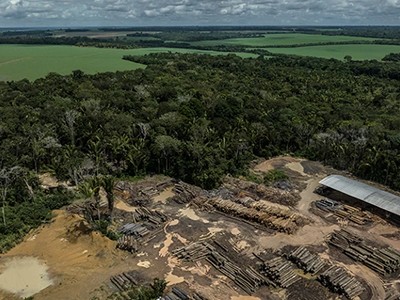[ad_1]
More than three months into 2024, politicians in Brazil are still at odds about how much money the country’s research institutes and federal universities will receive this year. Scientists say that unless more funding is found, they won’t have enough money to cover basic expenses such as water, electricity and financial aid for students.
On one side of the bargaining table is the National Congress. In December, it imposed cuts to the 2024 budget for the country’s research and higher-education institutions, which have already had their funding slashed several times in the past decade.
On the other side is the administration of President Luiz Inácio Lula da Silva, which is fighting to reverse some of the congressional cuts. Lula, as the leader of the leftist Workers’ Party is popularly known, took office in 2023 pledging to make science a priority, increase Brazil’s spending on research and eliminate deforestation.
“We should be doing research to support conservation policies, but now we are in a situation where we don’t know if we will be able to cover our routine activities,” says Nilson Gabas Júnior, director of the Emílio Goeldi Museum in the Amazonian city of Belém, whose studies provide data that feed into the management of the Amazon rainforest.
Although the cuts affect the entire country, the Amazon institutions argue that they are the hardest hit because their federal support is already disproportionately low.
Temporary reprieve
Lula managed to increase the budget for science and technology in 2023, compared with the levels in 2022, and scientists had hoped that funding would at least remain stable in 2024. Instead, Congress, which is controlled by a conservative majority, slashed the 2024 budget of the Ministry of Science, Technology and Innovation, which funds Brazil’s 16 federal research institutes, by 6.8% compared with that in 2023. Congress also reduced the budget for higher education from 6.3 billion reais (US$1.24 billion) in 2023 to 6.0 billion reais in 2024.
After the budget was passed, an organization that represents the interests of the 69 Brazilian universities supported by the federal government published an open letter calling for more funding. Scientists’ allies in Congress have also tried to persuade legislators to reconsider their decision.
In March, the government and Congress reached an agreement to restore 250 million reais to federal universities’ funding. But Sylvio Mário Puga Ferreira, dean of the Federal University of Amazonas in Manaus, who was involved in the negotiations, points out that “it would take a funding increase of 2.5 billion reais just to bring the universities’ budget closer to 2017 levels”.
Winner take all
The paltry funding for federal universities and research institutes is likely to exacerbate an already-grim situation for science in Brazil’s Amazon. Data from the National Council for Scientific and Technological Development (CNPq), Brazil’s largest government agency for research funding, indicate that only 4% of the money invested in research projects in 2023 was directed to institutions in the seven states classified as the North region, which encompasses 87% of the Brazilian Amazon.
“Scientific activity in Brazil is heavily concentrated in a few education and research institutions in the South and Southeast” regions, says Odir Dellagostin, president of the Brazilian National Council of State Funding Agencies. “They boast the best graduate programs, produce and publish more research and offer the best job opportunities” — and receive the most funding.
‘We are killing this ecosystem’: the scientists tracking the Amazon’s fading health
The problem extends to biodiversity research. A study1 analysing CNPq’s investments in projects in botany, zoology, ecology and limnology (the study of freshwater ecosystems) between 2016 and 2022 found that research groups from the North region received only 2.57 million reais during this period. “This situation leaves the region with a very limited capacity to respond to the threats the forest faces,” says Lis Stegmann, one of the study’s authors and a biologist at the Eastern Amazon branch of the Brazilian Agricultural Research Corporation (Embrapa), in Belém. CNPq did not respond to Nature’s request for comment.
Institutions in the North region produce fewer — and lower-quality — research outputs than do those in the South and Southeast regions, in part because they have difficulty training and attracting highly qualified personnel, and getting funding. In 2022, the seven Amazon states accounted for 3.9% of Brazil’s scientific production, whereas the state of São Paulo alone accounted for 28.9%, according to an unpublished study by Dellagostin.
Funding feedback loop
This leads to a self-perpetuating problem: decisions about who gets research funding in Brazil are based heavily on quantitative assessments. Scientists who produce more research and publish in high-impact journals have better chances of acquiring funding.
“Amazon research institutions are caught in a vicious circle,” says Emmanuel Zagury Tourinho, dean of the Federal University of Pará. “They don’t have enough funding because they lack robust scientific production, but they also cannot develop their research capacity because they don’t have enough funding.” This has led to a situation in which researchers from São Paulo (around 3,000 kilometres away from the Amazon) receive more public funding to study Amazon biodiversity than do researchers who are actually located in the Amazon.
Some scientists are still hopeful that they will get some extra funds this year. “We are talking to the [science] minister Luciana Santos about the possibility of additional budget allocations for the upcoming months,” Gabas says. The most likely scenario, however, is that this discussion will be postponed until the next budget, because some of the funds that were earmarked for science and education in 2024 have already been redirected.
[ad_2]
Source Article Link


